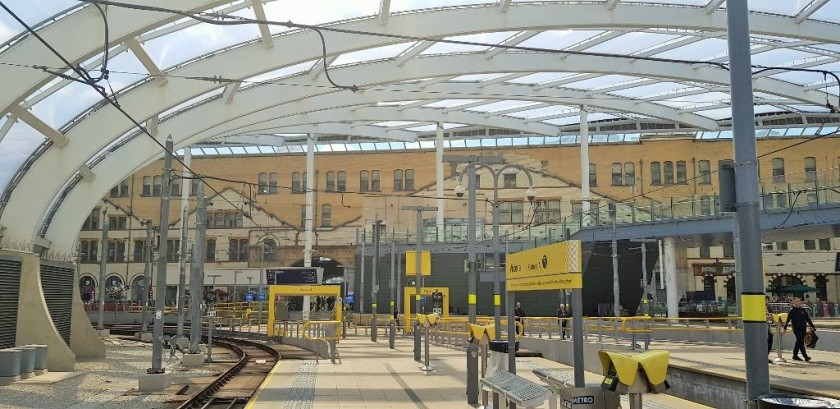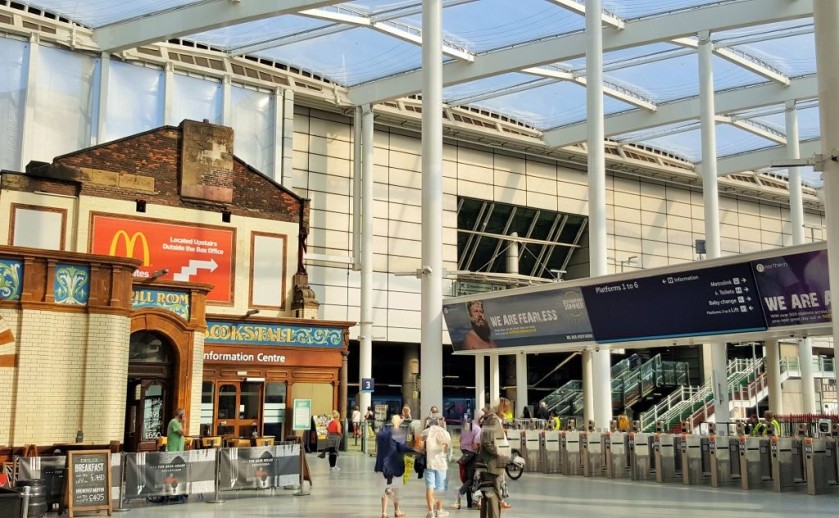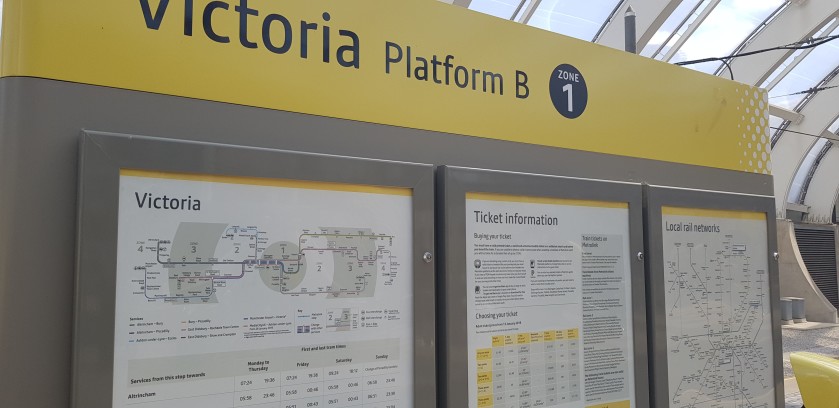Related Content
Content

Manchester Victoria (Manchester)
Welcome to the guide to using the main railway station on the northern edge of Manchester city centre.
Share
At a Glance
Onward Travel
Metro
Taxi Rank
Accessibility
Step Free






By the time the world’s first city to city railway was constructed, central Manchester was already a built up area, so similarly to London, the city centre, is ringed with multiple stations.
The other main station in the city is Manchester Piccadilly and many trains to and from Piccadilly also call at Oxford Road station.
Manchester Victoria was the northern most of these multiple stations in Manchester, so it’s closest to the attractions on that edge of the city centre including the National Football Museum and The Corn Exchange.
The Manchester Arena was built on and around part of Victoria station.
Destination guide:
Many trains from Manchester call at multiple stations in the city, but if you’ll be heading to some destinations in Yorkshire including Bradford, Halifax and Hebden Bridge, you will need to take a train from Victoria station as it is the only station in the city which has trains to those towns; a legacy of it being opened by the Lancashire and Yorkshire Railway.
You will also have a wider choice of trains from Manchester Victoria when travelling to Leeds, York and Newcastle.
Though if you haven’t reserved seats, be aware that one train per which head to Leeds and York, will have called first at Oxford Road and Piccadilly stations; so spare seats can be harder to find when boarding at Victoria.
Manchester Victoria also has the fastest trains from the city to Liverpool and boarding those trains at Victoria is less awkward than at Oxford Road and Piccadilly stations; at Victoria station they usually depart from platform (track) 3, which is right beside the main concourse.
Trains to many destinations to the south of Manchester including Birmingham, Bristol, Exeter, Oxford, Southampton and London only depart from Piccadilly station.
Though a quirk of how the trains to and from Manchester are managed is that many destinations to the north and west, are also now only served by trains which call at the other stations to the south of the city centre, including Oxford Road and Piccadilly.
So the towns and cities now not served by direct trains from Manchester Victoria station include Blackpool, Carlisle, Glasgow, Grange Over Sands, Lancaster, Llandudno, Oxenholme, Penrith and Rhyl.
Not that long ago all of these places were served by trains from Manchester Victoria
If you will be heading to one of those destinations not served from this station and the starting point of your journey is in the area around Manchester Victoria, the easiest option is take a tram across the city centre to Piccadilly station.
Connecting to the Metrolink trams:



Manchester Victoria now houses an impressive easy to use, step-free transfer between the trains and the trams.
Though the ticket counters on the concourse at Victoria station don't sell tram tickets, they can be purchased from the machines at the tram stops.
Also taking the tram is recommended for most end-to-end journeys which involve a transfer between Victoria and Piccadilly stations, particularly if you’ll be taking train from or to Piccadilly, which departs from or arrives at the main concourse at that station.
This includes the trains from and to Birmingham, Bristol, Exeter, Oxford, Southampton and London.
Though if you will be connecting to and from some other destinations including Sheffield and Nottingham, you’ll have an easier transfer if you take one of the two trains per hour between Victoria and Piccadilly stations.
To Manchester Airport:
A relatively new development is that Manchester Victoria station now has an hourly train service to Manchester Airport.
However, this is a less frequent service than what’s available when heading to the airport from Oxford Road or Piccadilly stations, but boarding these trains to the airport at Victoria is more straightforward than at those stations.
The journey time by train is scheduled to be 34 minutes, which is faster than the direct trams, as they take 57mins to reach the airport.
Though the 'Navy' line of the Metrolink tram system goes direct to the airport from Victoria every 12 minutes.
Heading to Manchester by train:
When travelling to the city centre by train from a destination to the north of Manchester, if there’s a choice of routes between trains calling at Victoria or Piccadilly don’t assume that because Piccadilly is considered to be the main station in the city, that you should choose to head there in preference to Victoria.
Not only is Victoria station closer to many parts of the city centre, the trains to Piccadilly from multiple towns and cities including, Bolton, Chester, Liverpool, Southport and York arrive at a part of that station which is awkwardly sited, at its furthest point away from the city.
Or if you’ll be taking a train which calls first at Victoria station, before going on to Oxford Road and Piccadilly stations, check the location of your final destination; it’s highly likely that you’ll have a faster and easier end-to-end journey if you leave the train at Manchester Victoria.
If you hop on a tram, you can be on the other side of the city centre before a train has even arrived at those other stations.
Departing by train:


If you take a taxi to Manchester Victoria, or use its original entrance on the street named Station Approach, when you step on to the main concourse, it will seem as though you’re at Britain’s most fabulous tram stop.
The trams now arrive and depart from an extension to the station, which is right beside the main concourse, so the access between the main station buildings and the trams is step-free.
However, when viewed from the main concourse, most of the trains which use the station are somewhat out of sight.
Despite having been reconstructed twice in the past 25 years, most of the grand station buildings which date to the 1880s are remarkable survivors, including Britain’s most ornate station café.
This older part of the station, including its ticket counters, is arranged along the back of the main concourse, opposite the trams.
That’s because many of the trains which once departed from Victoria used the area that’s now occupied by the tram stops.
Platforms (tracks) 1, 2 and 3 all directly linked to the main concourse, so have step-free access, platform 3 is normally used by trains heading to Liverpool and Manchester Airport.
On the other side of the ticket barriers on the main concourse are two bridges, but the bridge on the left offers the quickest access to platform (tracks) 4 – 6.
The express trains to Leeds, York, Middlesbrough, Newcastle and Redcar usually depart from platform 4.
You don’t have to use the stairs to access these platforms from the ticket gates, on the other side of the bridge is a somewhat hidden lift/elevator.
Other elevators connect this bridge to the trains.
Something to watch out for is that another bridge spans the station, it is accessed by a large staircase on the concourse which is beside the access to the tram stops.
However, those stairs lead to an entrance to the Manchester Arena and a car park, the clue that it doesn’t lead to the trains, is that it can be accessed without passing through the ticket gates.
Platforms 3 – 6 are all divided along their length into ‘a’ and ‘b’ sections and most trains tend to depart from the specific sections of these platforms; so you will see 6a and 3b etc on the departure indicators.
So keep the letters as well as the numbers in mind when heading to the trains, though when you’re on the platforms, each part has its own departure indicator, so use them as a guide to where to wait for your train.
Arriving by train:

If your train arrives at platforms 1 – 3, you’ll be adjacent to the ticket gates, which give access to the concourse and the exits.
When arriving by train at platforms 4 -6, you will have to use a bridge to access the ticket gates, though you won’t have to reach the bridge by using the stairs.
If your train arrives at platforms 4a – 6a, the lifts/elevators will be out of sight on the other side of the bridge.
Another lift/elevator will lead down from the bridge to the ticket gates.
Once you’ve turned to the left from the ticket gates, at the far end of the concourse is the main exit from the station, which leads to the city centre; off to the left is the access to the tram stops
To access the taxis, you can go to the right, using the exit which has a beautifully preserved tiled map of the former Lancashire and Yorkshire Railway on its wall.
Taking the tram to popular destinations:


Buy tickets before boarding from the machines at the tram stops – a zone 1 journey costs £1.40.
Yellow route trams heading to Piccadilly call at Market Street and Piccadilly Gardens – this tram link is the easiest means of making the transfer between Piccadilly and Victoria stations.
Note that only this tram line goes to Piccadilly, the other trams to the city centre, don’t go there.
For the Etihad Stadium takes these trams to Piccadilly Gardens and then connect there for Blue or Orange route trams heading to Ashton and leave these trams at the Etihad Campus stop.
All of the other tram routes into the city centre stop at St Peter’s Square and Deansgate-Castlefield and at Cornbrook.
At St Peters Square interchange is available with the blue and orange routes which head to Eccles via Media City
The Media City UK stop has easy access to The Lowry Museum/Theatre and The Granada Studio Tours.
At Cornbrook you can connect into the trams on the red route to the Trafford Centre, which now stops right by the The Imperial War Museum, Manchester and at Wharfside, which is a 5 min walk from the Old Trafford football stadium.
Day Trips By Train from Manchester
Manchester sits on spiders web of railway routes, so the city is a great base for taking easy day trips by train to other fabulous cities, stunning countryside, the coast and multiple steam railways.
Please support ShowMeTheJourney
This second version of ShowMeTheJourney is exciting and new, so we are genuinely thrilled that you are here and reading this, but we also need your help.
We’re striving not to let anything get in the way of providing the most useful service possible, hence a facility has been set up with DonorBox which can be used to support the running costs and make improvements.
Instead of advertising or paywalls, your financial support will make a positive difference to delivering an enhanced service, as there’s a lot of ideas which we want to make happen.
So if you have found the info provided here to be useful, please go here to say thank you.
Journeys
# Jump to a directionDirections
Journeys from Manchester Victoria
Jump to directionsManchester to Chester by train
Manchester to Leeds by train
Manchester to Liverpool by train
Manchester to Newcastle by train
Manchester to York by train
This second version of ShowMeTheJourney is exciting and new, so we are genuinely thrilled that you are here and reading this, but we also need your help.
We’re striving not to let anything get in the way of providing the most useful service possible, hence a facility has been set up with DonorBox which can be used to support the running costs and make improvements.
Instead of advertising or paywalls, your financial support will make a positive difference to delivering an enhanced service, as there’s a lot of ideas which we want to make happen.
So if you have found the info provided here to be useful, please consider saying thank you.

This is one of more than 100 train travel guides available on ShowMeTheJourney, which will make it easier to take the train journeys you want or need to make. As always, all images were captured on trips taken by ShowMeTheJourney.








